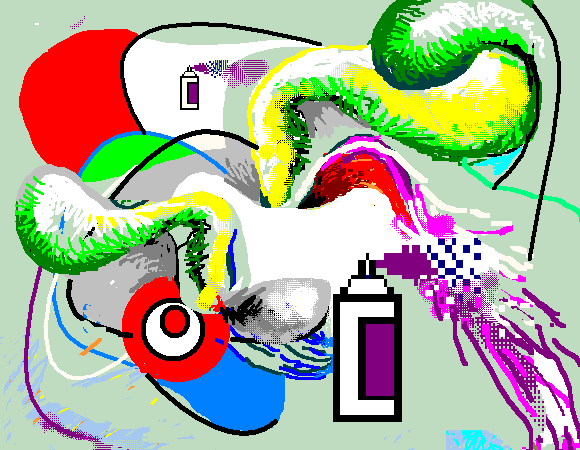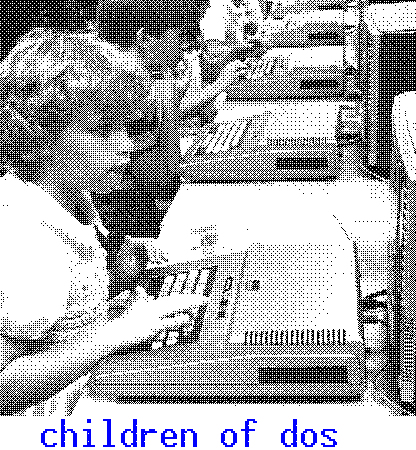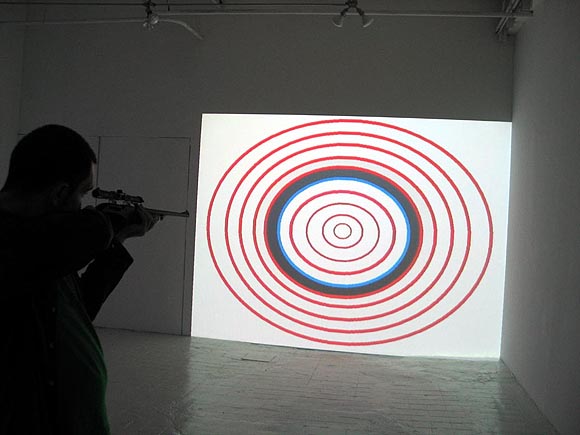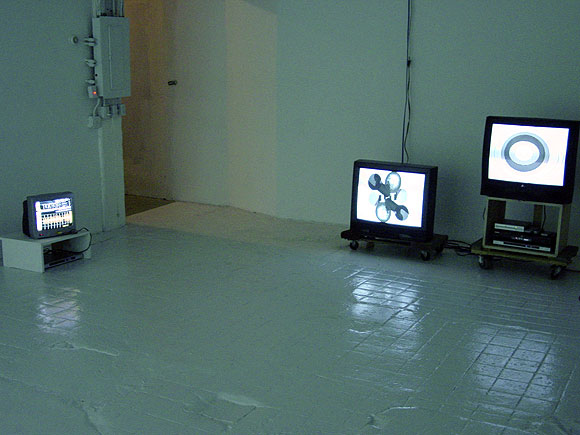View current page
...more recent posts
"Rubber Elephants" [mp3 removed]
The tune started out as the Conlon Nancarrowish "Piano Three Hands," which I've been saying mainly sounds that way because of the pianos. Here I used a Moog-like synth playing the same notes as the earlier piece(s) (plus some new percussion). It's burbly and perenially slightly out of tune so I gave it a new title. It could also be Switched-On Inebriated Bach.

Image from the New York Times, during the run-up to the US invasion of Iraq.
The scenario was deeply ironic and cynical, yet average Americans took it on faith that war was necessary and being glorified. The glib news media didn't believe a word of the propaganda they dispensed, yet put the utmost creativity into fostering a sense of urgency. We could be talking about the Iraq war, but the subject is Starship Troopers, Paul Verhoeven's film of Robert Heinlein's not-so-crypto-fascist novel. It's hard not to watch it today without seeing it as a blueprint for how the New York Times, Washington Post, and the other major media sold Bush's war. Verhoeven cast attractive then-unknowns as the film's citizen soldiers and their intertwined stories completely grab you, even though the movie's oft-stated belief in force and violence as the ultimate arbiter of the greater good is dangerous malarkey. Similarly, the Times and Post played its part in stoking the masses, not just with Judith Miller's fabricated scare stories about Iraqi superweapons, but with the front page photos of soldiers hugging their loved ones as they prepared to depart for the habitat of the dangerous colonial Other. U.S. tanks and warplanes overran Iraq's borders, even though, as we all know, the country had nothing to do with the 9/11 attacks; Troopers briefly suggests, only to sneeringly dismiss it, that humans started the war by encroaching on the alien bugs' Galactic turf. Yet the Times and its ilk devoted little ink to root causes, in their bloodlust, misplaced desire for 9/11 revenge, and crass schemes to sell papers. Small surprise that Verhoeven saves one of the most gruesome deaths for an embedded reporter, whose last moments are filmed by a transfixed cameraman who doesn't put down his recording device to help.

10 Songs for Analog Drum Machine & Sidstation
(These have all been posted before, just not as a group, except briefly over on the left. I just acquired an analog synth, which will probably get its own suite, then duets with the Sidstation, etc.)
"Two Bass Salad" [mp3 removed]
"Protest Song (Human Crab Louse)" [mp3 removed]
"Suite 6" [mp3 removed]
"Protest Song Variation" [mp3 removed]
"Crickets" [mp3 removed]
"Godhopper" [mp3 removed]
"Marching Morons" [mp3 removed]
"Clip City" [mp3 removed]
"Permanent Chase" [mp3 removed]
"Slow Hooterville" [mp3 removed]
Bonus tracks with the same instrumentation:
"artMoving" [mp3 removed]
"Suite 6 (Almost Live)" [mp3 removed].

artist unknown - thanks to MBS for reminding me about that GIF scraper page for LiveJournal - there was so much good stuff I had to stop downloading so I could have a life -
"Amiable Floater" [mp3 removed]
Not that it matters, but the sound generation of this song is 100% analog. The computer was used only to trigger note on/off and velocity and to record and mix. The rest of it's voltages and filtering and a lot of layering. The genesis of it was that the drum machine I'm using has three tunable drums that can either be kicks or toms. I tuned them so the drum hits could be played like a bass line. The piece isn't really all that amiable--it gets a bit mysterious at the end during the "acid" part. The overall texture makes me think a little of Derrick May's work, which was the first techno music I really started studying. Not sure why exactly--kind of a jazzy feel?
It's a good headphone piece, I think.
Every couple of weeks the art and technology website Eyebeam reBlog invites a guest reBlogger to act as a combination curator, editor, and DJ, surfing and reposting noteworthy material from blog feeds. Paddy Johnson criticizes the tendency of the reBloggers of late to rely too much on known "tech news" sites (Make, Boingboing, et al) for recycled material. I agree with her, but then I would, because the practice violates my own self-declared "rules for reBlogging," posted at the end of my gig there in '04.
Generally speaking, there are entirely too many stories in the category Michael Bell-Smith calls Talking Refrigerators.
These are whimsical items about some engineering marvel, usually from a college robotics department or venture capital startup, that are at best consumerist PR and at worst the kind of ridiculous '50s gee whiz utopianism that we all should know by now has a down side and a dark side (just thinking of that nightvision video clip of the helicopter gunner blasting a wounded Iraqi soldier to hamburger--"squeeze the joystick, instant no soldier!").
Case in point: a recently reBlogged item offers a clip from a local news station about an alarm clock that rolls off your nightstand, forcing you to chase it across the floor until you wake up. Hey, that same fuzzy gear could be repurposed to make "rolling landmines" that follow you around till they blow your legs off! Less fluff, more stories about the world we live in I guess is what I'm hoping for.
And from the not-biting-the-hand-too-hard-that-feeds-me department, thanks to L.N.R., George Hotelling, Angus Galloway, Perry Lowe, Huong Ngo, Evan Roth, and David Jacobs for reBlogging me this year--you guys rule!

The critics (i.e., other artists) take aim. Referencing the interview Paddy Johnson did with Michael Bell-Smith and me, Joe McKay recently posted a comment that applies to the discussion about LCDs, CRTs, projections, and the like. (He didn't actually taking potshots in it--the remarks were some of the most supportive writing I've gotten.) I've tacked it on to my post-interview follow-up to Mike's last comment in the interview, as if it were a real conversation and not some cobbled-together thing.
MBS: [...] The work in the [Foxy Production] show was created with a gallery in mind and I wanted it to feel that way. Rather than playing off the tensions of bringing new media into the gallery - as I feel Tom has with his show – I wanted it to feel like a natural fit, again, like maybe this is just how we make art these days.The photo at the top of Marcin Ramocki, artist, vertexList gallery proprietor, and sharpshooter, is courtesy artMovingProjects. Below is my installation shot showing the TVs in my just-closed exhibition.
I don’t think flat screens in a gallery feel especially high tech. For me they’re less loaded than traditional TVs/monitors (which feel consciously lo-tech), high end CRT NTSC monitors (which tie into a history of video art in the gallery) or large projections (which feel cinematic or as Tom pointed out, aggressive).
For me, the containment of wall-mounted flat screen monitors is about putting the work on a physical and spatial par with painting, drawing or photography. I think creating that kind of familiar physical relationship between the viewer and the work may serve to combat the tech gap: at the very least the viewer knows how to deal with the piece on a physical level. [...]
TM: These are good points. I want to add that, although I recently did a blog post called "Showing new media work in a gallery: what's at stake," that isn't the main content of my show, any more than Mike's content was his delivery system. The gear I used is to deliver the strongest statement--which is to say, to get the most out of the pulsing abstractions, repurposing of a Star Trek sensor as a "simulacratracker" (as one commenter described it), and the embarassing acting out (or faux acting out) of Guitar Solo (which actually is on a tiny flat screen). I've argued with a couple of people about my use of tube TVs instead of LCDs for three of the pieces. I chose the tubes because they deliver a punchy image, punchier to me than what I'm seeing on flats these days. Tubes aren't that "retro"--J&R Music and Video still has a wall of CRTs for sale as an alternative to the wall of LCDs. I know, it won't last, but we're talking about the present. Translating animated GIFs from a computer to a single dedicated image on a TV adds an element of the unexpected, and a gritty texture I like. These choices aren't just to emphasize "new media in the gallery"--although that's definitely an aspect of the content.
Joe McKay: Tom, I felt your CRTs and DVD players had content. It took a minute to figure out what was wrong, but you just don't see home made GIFs on T.V. When I see a CRT I still think "T.V." - when I see a flat panel, I think monitor, be it video, computer or tv as its input. It made your show interestingly disquieting.
In a sense, the DVD froze the GIFs in time. I liked the presentation of Michael's work but the fact that they were playing off of computers made me wish that some of the content was being dynamically created and not just loops. But I can understand his decision, it is "computer art" so why not have it play off of a computer? It keeps the work from being "just a video", and is way easier for a collector to get her/his head around.
When I saw your show I felt that the projection was in conversation with the Ecstasy show, (even though I'm pretty sure you didn't see it, it was up in LA).
I felt your piece was a deliberately low tech attempt at sensory overload. The big problem with Ecstasy was the fact that every piece was expensive, and expensive looking. What I enjoyed about both yours and Michael's show was the humor, something that's in short supply in a lot of digital media.

